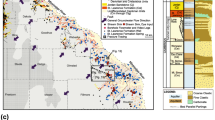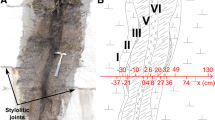Abstract
A hydrogeological study was conducted in Potsdam sandstones on the international border between Canada (Quebec) and the USA (New York). Two sandstone formations, arkose and conglomerate (base) and well-cemented quartz arenite (upper), underlie the study area and form the major regional aquifer unit. Glacial till, littoral sand and gravel, and marine silt and clay discontinuously overlie the aquifer. In both sandstone formations, sub-horizontal bedding planes are ubiquitous and display significant hydraulic conductivities that are orders of magnitude more permeable than the intact rock matrix. Aquifer tests demonstrate that the two formations have similar bulk hydrologic properties, with average hydraulic conductivities ranging from 2 × 10−5 to 4 × 10−5 m/s. However, due to their different lithologic and structural characteristics, these two sandstones impose rather different controls on groundwater flow patterns in the study area. Flow is sustained through two types of fracture networks: sub-horizontal, laterally extensive fractures in the basal sandstone, where hydraulic connectivity is very good horizontally but very poor vertically and each of the water-bearing bedding planes can be considered as a separate planar two-dimensional aquifer unit; and the more fractured and vertically jointed system found in the upper sandstone that promotes a more dispersed, three-dimensional movement of groundwater.
Résumé
Une étude hydrogéologique a été entreprise dans les grès de Potsdam, sur la frontière entre le Canada (Québec) et les Etats-Unis (New York). Sous le secteur d’étude, deux formations gréseuses, les arkoses et conglomérats (base) et les arénites quartzeuses cimentées (sommet), forment une unité aquifère majeure à l’échelle régionale. Les moraines glaciaires, les sables et graviers littoraux, et les argiles et silts marins recouvrent l’aquifère de manière discontinue. Dans les deux formations gréseuses, les litages sub-horizontaux sont omniprésents, et présentent des conductivités hydrauliques significatives, supérieures de plusieurs ordres de grandeur à celles de la matrice rocheuse intacte. Les pompages d’essai démontrent que les deux formations ont des propriétés hydrologiques apparentes comparables, avec notamment des conductivités hydrauliques comprises entre 2 × 10−5 et 4 × 10−5 m/s. Cependant, du fait de leurs lithologies et de leurs caractéristiques structurales contrastées, ces deux formations gréseuses imposent des contrôles différents sur les écoulements souterrains dans le secteur d’étude. L’écoulement est soutenu par deux types de réseaux de fractures : des fractures latéralement extensives sub-horizontales dans les grès de base, où la connectivité hydraulique est très bonne horizontalement mais médiocre verticalement, et où chacun des plans aquifères peut être considéré comme une unité aquifère isolée plane bidimensionnelle, et un système fissuré verticalement et plus fracturé situé dans les grès supérieurs, qui favorise des écoulements souterrains tridimensionnels et plus dispersés.
Resumen
Se realizó un estudio hidrogeológico en las areniscas Potsdam sobre el límite internacional entre Canadá (Quebec) y Estados Unidos de América (Nueva York). Dos formaciones de arenisca, arkosa y conglomerado (en la base) y arenita de cuarzo bien cementada (en la cima), componen el área de estudio y forman la principal unidad regional de acuífero. Conglomerado glacial, grava y arena litoral, y arcilla y limo marino sobreyacen discordantemente el acuífero. En ambas formaciones de arenisca existen abundantes planos de estratificación subhorizontales que muestran conductividades hidráulicas significativas que son varios órdenes de magnitud más permeables que la matriz de roca intacta. Las pruebas de acuífero demuestran que las dos formaciones tienen propiedades hidrológicas globales similares, con conductividades hidráulicas promedio que varían de 2 × 10−5 a 4 × 10−5 m/s. Sin embargo, debido a diferencias litológicas y características estructurales, estas dos areniscas imponen controles muy distintos en los patrones de flujo de agua subterránea en el área de estudio. El flujo es sostenido a través de dos tipos de redes de fracturas: fracturas subhorizontales lateralmente extensivas en la arenisca basal, donde la conectividad hidráulica es muy buena horizontalmente pero muy pobre verticalmente y cada uno de los planos de estratificación acuíferos puede ser considerado como una unidad acuífero en 2 dimensiones plana y separada; y el sistema de fracturas verticales que se encuentra en la arenisca superior que promueve un movimiento de agua subterránea más disperso en 3 dimensiones.














Similar content being viewed by others
References
Benoît N, Pasquier P, Marcotte D, Nastev M (2005) Conditional stochastic inverse modelling of the Châteauguay river aquifers. ModelCare 2005, The Hague, Netherlands, 6 pp, CD version
Blanchette D (2006) Caractérisation géochimique des eaux souterraines de la région du bassin versant de la rivière Châteauguay, Québec, Canada [Groundwater chemistry in the Chateauguay River watershed, Quebec, Canada]. MSc Thesis, Institut National de la Recherché Scientifique INRS-ETE, Quebec, 71 pp
Bradbury KR, Rothschild ER (1985) A computerized technique for estimating the hydraulic conductivity of aquifers from specific capacity test data. Ground Water 23:240-246
Clark TH (1966) Chateauguay area. Geological report 122, Quebec Department of Natural Resources, 63 pp
Croteau A (2006) Détermination de la distribution spatiale et temporelle de la recharge à l’aquifère régional transfrontalier du Bassin Versant de la Rivière Châteauguay, Québec et Etats-Unis [Estimation of spatial and temporal recharge in the Chateauguay River transboundary aquifers, Quebec and United States]. MSc Thesis, Institut National de la Recherché Scientifique INRS-ETE, Quebec, 71 pp
Croteau A, Nastev M, Lefebvre R, Lamontagne L, Lamontagne C, Lavigne MA, Blanchette D (2005) Estimation of spatial and temporal distribution of recharge to The English River aquifer system, Quebec. 6th Joint IAH-CNC and CGS Groundwater specialty conference, Saskatoon, SK, September 2005, 8 pp, CD version
Dagenais MP, Nastev M (2005) A case study of a conflict over groundwater-when hydrogeology is not sufficient. 6th Joint IAH-CNC and CGS Groundwater specialty conference, Saskatoon, SK, September 2005, 8 pp, CD version
Environment Canada (2007) Species at risk http://www.speciesatrisk.gc.ca. Cited 24 December 2007
Freeze RA, Cherry JA (1979) Ground water. Prentice-Hall, Englewood Cliffs, NJ
Globensky Y (1987) Geology of the St. Lawrence Lowlands. General Direction for Geologic and Mineral Exploitation, Report MM 85-02, Quebec Ministry of Energy and Resources, Quebec, 63 pp
Godin R, Rouleau A (2005) Essais permeametriques en forages dans le socle rocheux du bassin versant de la Riviere Chateauguay [Constant head injection tests in bedrock wells in the Chateauguay River watershed]. Report prepared for the Ministère de l’Environnement du Quebec, Quebec
Lavoie D (2005) Geological, stratigraphical and structural settings of the Chateauguay area, St. Lawrence platform of southern Quebec. http://www.ess.nrcan.gc.ca/2002_2006/gwp/p3/a8/bed_e.php. Cited 24 December 2007
McCormack R (1981) Étude hydrogéologique-Bassin versant de la Châteauguay [Hydrogeological study of the Chateauguay River watershed]. Inventory and Research Division, Quebec Ministry of Environment, Quebec, 175 pp
Molz FJ, Morin RH, Hess AE, Melville JG, Guven O (1989) The impeller meter for measuring aquifer permeability variations: evaluation and comparison with other tests. Water Resour Res 25:1677–1683
Morin RH, Hess AE, Paillet FL (1988) Determining the distribution of hydraulic conductivity in a fractured limestone aquifer by simultaneous injection and geophysical logging. Ground Water 26:587–595
Nastev M, Lamontagne C, Tremblay T, Lavoie D, Hardy F, Lamothe L, Croteau A, Blanchette D, Lavigne M-A, Roy N, Paradis D, Benoît N, Lefebvre R, Marcotte D, Gaudin R, Rouleau A (2004a) Hydrogeological overview of the transboundary aquifers in the Châteauguay River Basin, Canada-United States. 5th joint IAH-CNC and CGS groundwater specialty conference, Quebec, October 2004, 7 pp, CD version
Paillet FL (1998) Flow modeling and permeability estimation using borehole flow logs in heterogeneous fractured formations. Water Resourc Res 34(5):997–1010
Salad Hersi O, Lavoie D, Mohamed AH, Nowlan GS (2002) Subaerial unconformity at the Potsdam-Beekmantown contact in the Quebec Reentrant: regional significance for the Laurentian continental margin history. Bull Can Pet Geol 50:419–440
Schroeder PR, Aziz NM, Lloyd CM, Zappi PA (1994) The Hydrologic Evaluation of Landfill Performance (HELP) Model: Engineering Documentation for Version 3.07, EPA/600/R-94/168b, USEPA, Washington, DC, 116 pp
Tremblay T, Lamothe M (2005) Géologie des formations superficielles du bassin-versant de la rivière Châteauguay [Geology of Quaternary sediments in the Chateauguay River watershed]. Une contribution de l’UQÀM au Projet Châteauguay, rapport final, 34 pp. http://www.ess.nrcan.gc.ca/2002_2006/gwp/p3/a8/quat_e.php. Cited 24 December 2007
Wiesnet DR, Clark TH (1966) The bedrock structure of Covey Hill and vicinity, northern New York and southern Quebec. US Geol Surv Profl Pap 550-D, pp D35–D38
Young SC, Pearson HS (1995) The electromagnetic borehole flowmeter: description and application. Ground Water Monit Remediat 15(4):138–147
Zemanek J, Glenn EE, Norton LJ, Caldwell RL (1970) Formation evaluation by inspection with the borehole televiewer. Geophysics 35:254–269
Acknowledgements
This work was supported in part by Geological Survey of Canada, US Geological Survey and Quebec Ministry of Sustainable Development, Environment and Parks. Dr. Claudio Paniconi from the Institut National de la Recherche Scientifique-Quebec is thanked for his constructive comments and review of the first draft of this manuscript.
Author information
Authors and Affiliations
Corresponding author
Rights and permissions
About this article
Cite this article
Nastev, M., Morin, R., Godin, R. et al. Developing conceptual hydrogeological model for Potsdam sandstones in southwestern Quebec, Canada. Hydrogeol J 16, 373–388 (2008). https://doi.org/10.1007/s10040-007-0267-9
Received:
Accepted:
Published:
Issue Date:
DOI: https://doi.org/10.1007/s10040-007-0267-9




